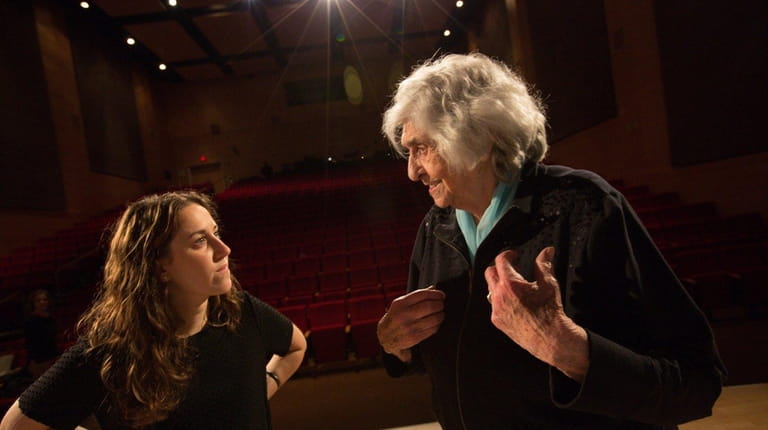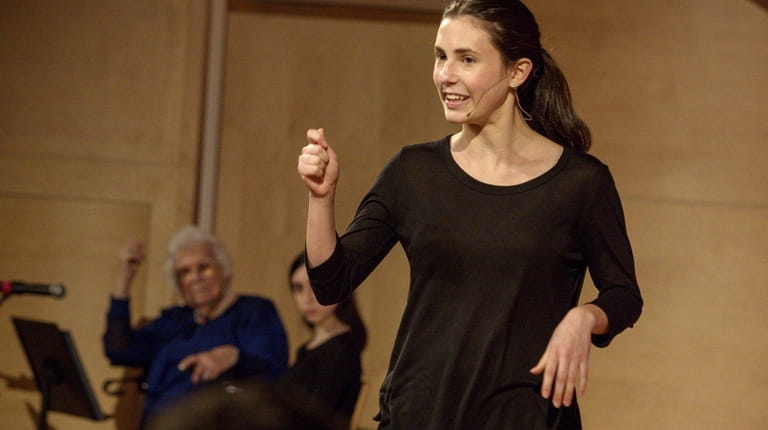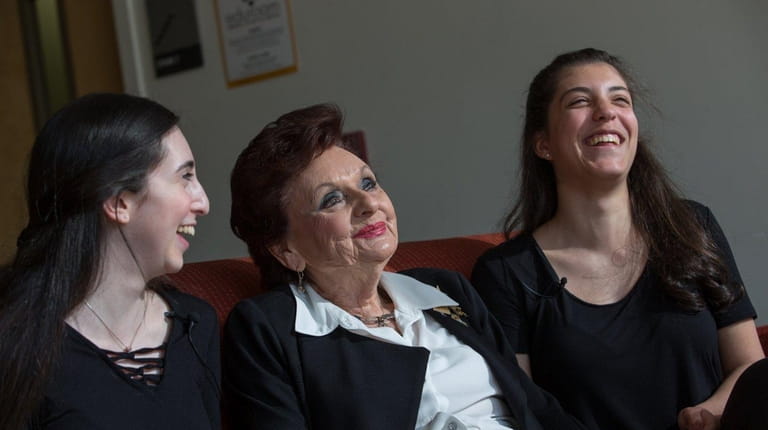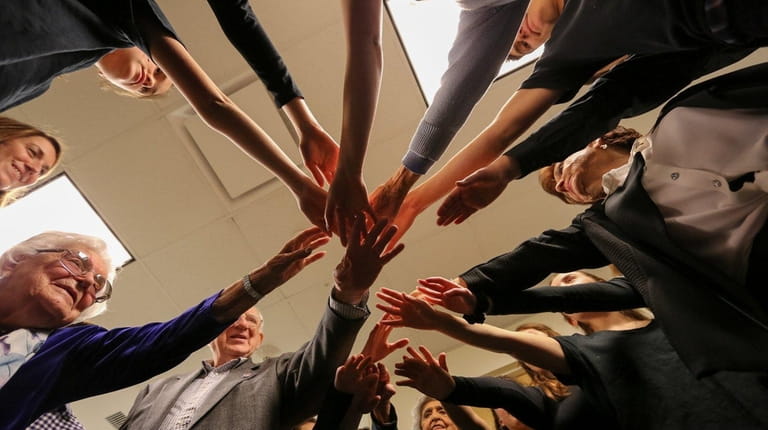Teens act out Holocaust survivors’ stories in Witness Theater

‘All Jews must sit in the back of the bus,” Friends Academy sophomore Julia Satovsky bellowed. To her right, a cluster of students on stage bent their knees, appearing destabilized.
“All Jews are no longer allowed to move.” The students knelt to the floor, splaying out as if in pain.
“All Jews must wear this star.” A clap — as palms pounded simultaneously once against the stage floor — reverberated ominously through the sold-out, 500-seat auditorium at Adelphi University in Garden City.
On April 16 and 17, 13 Long Island high school students took the stage for Witness Theater, a monthslong program during which select high schoolers act out Holocaust survivors’ stories before a live audience after spending months bonding and hearing their experiences firsthand. This intergenerational storytelling aims to create new “witnesses” to the Holocaust, while simultaneously acting as therapy for survivors.
The performance, made possible by UJA-Federation of New York and its nonprofit partner, Selfhelp Community Services, was the first of its kind on Long Island, and detailed five survivors’ accounts. Selfhelp first brought Witness Theater to New York from Israel in 2012.
“Repeating the story, it takes a toll on you because you’re reliving it,” said survivor Rachel Epstein, of Roslyn, whose birthday is Sunday. Epstein had arrived two hours before show time, flaunting black polka dot leggings and popping pink lipstick. “But every week I actually look forward to meeting with the students . . . They are the cream of the crop. ”
Roslyn High School senior Dana Wagner, 18, and sophomore Olivia Rubrum, 15, of Roslyn — who played Epstein at two different stages of her life in the performances — sat beside her. Epstein gave their hands a soft squeeze as she spoke.

Credit: Linda Rosier
“They showed us videos from [a previous Witness Theater] performance the first day, and I remember sitting there thinking, ‘Am I going to have one of these relationships?’ ” said Wagner, 18. “When I met Rachel . . . I definitely knew that I had that.”
A devastating past
It’s been more than 70 years.
Epstein’s life began peacefully in Compiègne, France, in 1932, with a backdrop of gardens and castles. But at 10 years old, her world shattered when French police knocked on her family’s second-floor door one early Sunday morning in July 1942, demanding that her parents go to City Hall for questioning. They never came back.

Director Barbara Kaynan, left, chats with Holocaust survivor Johanna Friedl after the rehearsal. Credit: Linda Rosier
“It became a big commotion; my brother and I were screaming,” Epstein recalled.
She learned later that her mother, 27, and father, 32, had died in the gas chambers at the infamous Auschwitz concentration camp. Epstein and her younger brother, Leon, were the only two of about 400 Jewish citizens from their village to survive. They hid openly under the care of their Christian neighbors, the Ribouleaus, for the remainder of the war.
The unique stories of the four other survivors are similarly rife with unimaginable loss and inspiring bravery. Johanna Friedl, 93, avoided being sent to Auschwitz by leaving Bratislava, Czechoslovakia, with her father and brother and later securing passage on a Turkish ship headed illegally for Palestine in winter 1939. But the ship became stuck in ice for more than a month — passengers were forced to use ice for drinking water — and the British caught them at sea. They were imprisoned in what is now Haifa, Israel, for six months.
“I just remember a lot of sand and barbed wires,” said Friedl, of Long Beach, maintaining that she “blacked out” that time in her life. By war’s end, she’d lost 12 aunts and uncles, and her grandparents.
Arthur Greenbaum, 93, who was tormented in school for being Jewish and once collected dead bodies in the Mauthausen concentration camp, still doesn’t know what happened to his two brothers who were drafted into the Hungarian Army during the war. Susan Braun, 79, lost her mother to a death march, and at age 5 witnessed soldier brutality in a Budapest ghetto that left her father with no teeth. And Sima Katz, 94, hid from Russian soldiers on a farm after escaping a Lithuanian ghetto, with no food or water for three days.

Sima Katz, left, mimics Micah Golan, who portrays her, during a rehearsal. Credit: Linda Rosier
There is often a false notion that Holocaust survivors are only those who were interned in concentration camps and ghettos, said Sandy Myers, Selfhelp’s vice president of external relations. The nonprofit offers a slew of services to Holocaust survivors, ranging from social outings to legal assistance.
In reality, the definition is “more broad” than that, she said. “Anyone whose life was altered by Nazi persecution is a survivor.”
Knowledge about the Holocaust in general has appeared to dwindle over time, despite the presence of about 45,000 survivors in the New York metropolitan area alone. Only 45 percent of Americans can name a single concentration camp or ghetto, for example, according to a survey released in April by the Claims Conference, a group that negotiates with the German government for compensation for Holocaust survivors and helps fund programs that provide home care, food, medical care and other support for survivors.
“The educational component is very important, especially now,” Witness Theater co-chair and UJA-Federation volunteer Rita Levy said. “So many people are not aware of what the Holocaust was about.”
That divide can make speaking to others about the war’s atrocities “very difficult,” said Greenbaum, of East Rockaway. “It’s very hard to explain to anybody what I went through; what the Jews went through.”

Rachel Epstein enjoys a lighthearted moment with the two teens who portray her, Olivia Rubrum, left, and Dana Wagner. Credit: Linda Rosier
But for the last eight months, the survivors have talked. And the students have listened.
Survivors get new voice
A key take-away of this year’s Witness Theater lives in the words of Holocaust survivor and Nobel Laureate Elie Wiesel: “When you listen to a witness, you become a witness.” The initiative presented an all-time-high 14 performances across four programs in the New York area in 2018, and the intention is to expand, Myers said.
Formatting across the board is similar: Each survivor has a segment of the Witness Theater performance dedicated to his or her experiences and can give personalized statements, typically at the beginning and end of their respective story. But otherwise, the students — who are now close to the ages of some of the survivors during the Holocaust — assume the role of acting out the survivors’ histories to the audience.
The program operates under the drama therapy model, defined as “the intentional use of theater in the healing process and the process for change,” drama therapist and director Barbara Kaynan said.
Survivors “gain some distance from their story, and perhaps new perspectives,” while students achieve “a whole different level of appreciation and understanding of what they went through . . .>. . It ends up generating such a large sense of community and connection and validation,” Kaynan said.

Students and survivors gather for warm-up exercises before the show. It was the first time Witness Theater has come to Long Island. Credit: Linda Rosier
The end product was a well-oiled machine, with all words memorized and all movements choreographed. But it took months of work.
First up was finding participants. Selfhelp began promoting the program in late spring 2017 to clients and via word of mouth, while high schoolers heard largely from parents, synagogues and mentors. While it’s often difficult to round up survivors willing or physically able to participate, there was a breadth of student interest, Levy said. She added that the program was limited to Nassau County students for “practical” reasons, given the local meeting and rehearsal locations.“We were very overwhelmed by the number of students who wanted to participate,” said Levy, noting that they closed the application process — which included a personal essay — once 30 students had applied.
Roslyn High School sophomore Robby Weingarten, 16, learned about the program from his mom, and immediately recognized the rare opportunity to tap into history.
“I’d only heard . . . [details about the Holocaust] once in my temple, so this was the first time I could actually hear Holocaust survivors’ stories,” he said. The concept “was really interesting to me.”
The first meeting with the survivors and students was in early September at the Sid Jacobson JCC in Greenvale. It began with “building group cohesion and comfortability,” Kaynan said.
Then, over the next few months, the meetings — every Thursday for two hours — shifted to storytelling in five areas: life before the war; the first time the war touched their lives; life during the war; liberation; and rebuilding. It’s common for extended, in-depth sharing to unearth memories survivors have buried, Kaynan said.
Levy, whose mother Sima Katz was one of the five survivors, saw her mother’s story through a different lens with Witness Theater. She’d never known, for example, that while hiding out on the farm, Katz was tasked with smothering her father-in-law, who had a chronic cough, should he start coughing while soldiers were present.
“She said to me for the very first time: ‘Can you imagine how I felt?’ ” Levy said. Her mother’s escape from the ghetto to the farm “were just things that happened. The idea of how she felt — that came out of this program.”
After months of storytelling and discussion, Kaynan produced a script and a “preconceived idea” of how staging would work. She also chose certain students to play the lead roles of the survivors based on the organic relationships she’d seen blossom during the program.
Satovsky and Friedl were one of those pairs. The two both “like to laugh” and gravitate toward each other, Friedl said, excitedly adding that Satovsky and another participant, junior Sarah Rubin, had invited her to spend an entire day with them in January at their school, Friends Academy in Locust Valley.
“Johanna and I are like best friends — right?” said Satovsky, 15, of Port Washington, turning to Friedl. “Yeah!” Friedl replied, beaming. “We just clicked together somehow.”
Once the script materialized, practice ramped up in January, with additional four-hour Sunday student rehearsals. The script was tailored to each story, with the survivors encouraged to exercise autonomy and provide feedback.
Epstein wanted the students to scream “Mama!” and “Papa!” like she did when her parents were taken away. Friedl wanted embedded humor to reflect her propensity for telling jokes. Greenbaum wanted his two brothers highlighted; he described one as a “well-dressed gentlemen” — the other “a big, tall guy who didn’t tolerate anything people said about the Jewish people.”
“I miss them very much,” he said. “I talk about them, I think about them. I have their pictures.”
Epstein’s story also incorporated a mix of contemporary and lyrical dancing because she’s “a really fantastic dancer,” said Rubrum, 15. During a dance that Rubrum performed in honor of the Ribouleaus, she wrapped her arms around herself, as if mimicking a hug.
“The Ribouleaus are such a big part of Rachel’s story, and I’m really excited to portray to the audience that without them, Rachel may not be here,” Rubrum said before the first performance.
Despite becoming so familiar with the speakers’ stories, quirks and passions, Satovsky said there’s still pressure to get it right on stage.
“It’s definitely a big burden because I want story to be shown how she wants it shown to everyone,” she said. “But I’m so grateful I was given the opportunity to, because everyone will hopefully be able to take it in.”
A lasting impact
By the time the second show ended, there were about 1,000 new witnesses to the Holocaust — an accomplishment Levy deemed “powerful.”
There had only been one show initially planned, she noted, but after demand wiped out the first show’s tickets in a day and a half, another one was scheduled. The performances raised more than $530,000 for UJA-Federation’s Community Initiative for Holocaust Survivors, which will ensure the funds are directed toward services that boost survivors’ quality of life.
On both nights, sheets of plain white paper waited in the lobby to be filled with audience reflections. They soon contained a swath of messages written with black and gold Sharpies: “Remarkable.” “Courageous.” “Hope.” “Never Again.”
Many of the survivors had entered the Witness Theater program with a hesitant optimism, they said. But now, there are no regrets.
“Maybe I did something good,” Friedl said. “Maybe now [people] will understand a little.”
The entire Witness Theater crew has also become “like family,” Friedl added, and all participants have expressed interest in staying in touch after their meetings conclude in May. Witness Theater as a whole will continue next year with new crops of students and survivors, though plans for Long Island are not solidified at this time, Myers said.
For Epstein, her love for all involved is going with her to the grave.
All of the participants’ “devotion to us made the story turn out to be a wonderful story,” she said. “I love them to pieces. I’ll be in my grave and I’ll still be screaming, ‘I love you!’ ”
Helping Holocaust survivors
There are 45,000 Holocaust survivors living in the New York metropolitan area, and about 40 percent of them are living in poverty. Many are socially isolated and their health in decline.
For this reason, Witness Theater on Long Island added a fundraising component to its program, raising more than $530,000 from two sold-out performances (according to Rita Levy, Witness Theater co-chair and UJA-Federation volunteer). It was the first program to raise funds since Witness Theater came to New York in 2012, said Sandy Myers, vice president of external relations for Selfhelp Community Services. Tickets are typically free to be “very focused on awareness,” she noted.
The fundraising was twofold: Show tickets were $15 each, and attendees were also encouraged to donate. One hundred percent of the proceeds will go directly to UJA-Federation’s Community Initiative for Holocaust Survivors, which will distribute the funds to nonprofit partners such as Selfhelp, which — for more than 80 years — has provided expansive services that now range from social events to legal aid, home health care and emergency cash assistance.
“People have been so supportive of the fundraising component,” Levy said. “This program is raising funds to help those survivors live with dignity and independence.”
To contribute, contact Dina Shuster at shusterd@ujafedny.org or call 516-762-5833.
— Taylor Swaak
Updated 50 minutes ago Teacher pay ... Trump in court today ... Santos' request to unseal witness statements ... Autism walk
Updated 50 minutes ago Teacher pay ... Trump in court today ... Santos' request to unseal witness statements ... Autism walk
